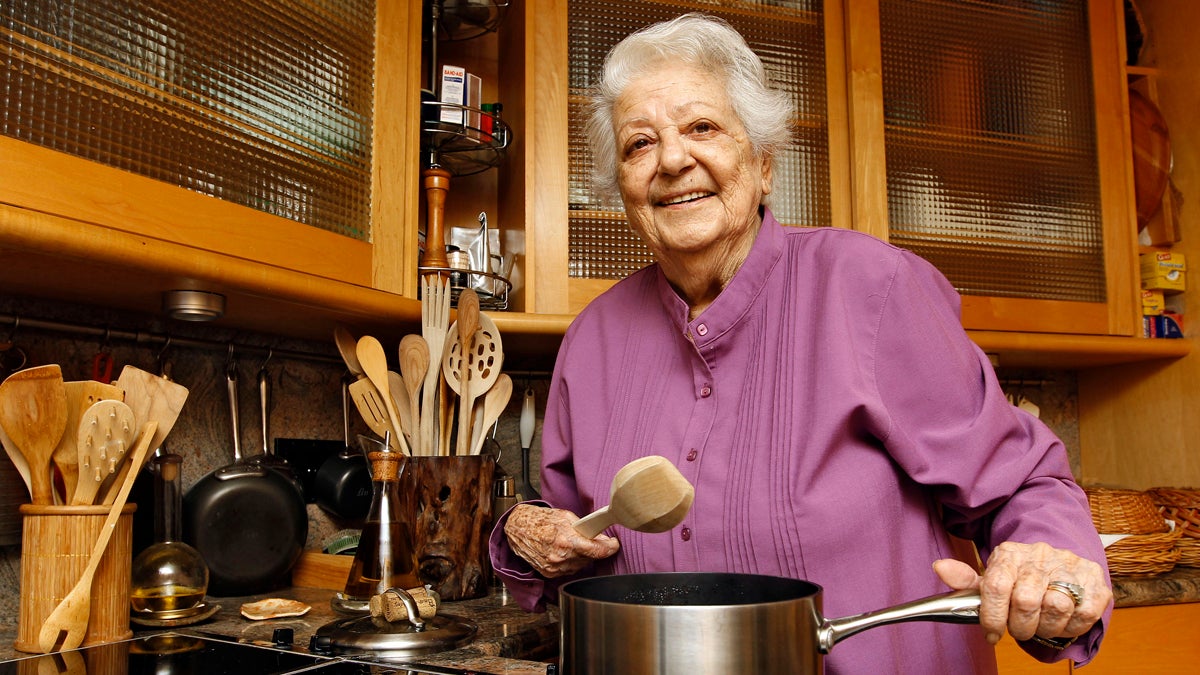No-nonsense nonna Marcella Hazan changed Italian cooking for all of us
Listen
In this May 29, 2012 file photo, chef Marcella Hazan poses in the kitchen of her Longboat Key, Fla., home. Hazan, the Italian-born cookbook author who taught generations of Americans how to create simple, fresh Italian food, died Sunday, Sept. 30, 2013 at her home in Florida, according to an email from her son, Giuliano Hazan. She was 89. (AP Photo/Chris O'Meara, File)
Even if you don’t cook, you must have noticed that The New York Times placed Marcella Hazan’s obituary on the front page on Sunday — a testament to her culinary legacy.
Hazan didn’t begin cooking until she emigrated to the States with her American husband, Victor. But when she did, she put all the intellect of a biology and natural sciences Ph.D. into codifying the recipes of her Italian homeland. Victor quickly became her partner and translator.
In my mind, Julia Child changed the way we cook, but Marcella Hazan changed the way we eat. It may be an exaggeration, but I firmly believe we’d still be putting that white stuff that came in a green cardboard can on our spaghetti thinking it was parmesan cheese were it not for her dogmatic approach to ingredients and technique.
Real Italian, real influence
In the mid-1970s Hazan’s book, The Classic Italian Cook Book: The Art of Italian Cooking and the Italian Art of Eating, took us from what we thought was Italian — red-gravy, jug chianti and checkered tablecloths — into the vast repertoire of Italian regional cuisine. By her second book, More Classic Italian Cooking, we all had hand-cranked machines to make our own fresh pasta for our primi — first course — because we now knew the noodle was not the meal, but rather just the beginning, to be followed by meat or fish and vegetables.
Hazan was a sought-after ticket when she created a menu for a “Book and the Cook” dinner at Toto’s, an iconic Italian restaurant at 14th and Locust streets in Philadelphia (where Estia now stands). Her introduction of real ingredients to the masses was certainly felt on 9th Street in the Italian Market — suddenly everyone wanted balsamic vinegar.
And I’ve no doubt that Hazan laid the groundwork for our current passion for local fresh vegetables. She instructed us over and over again that good Italian cooking was the highest-quality, freshest ingredients prepared simply. To this day, if I don’t have a whole fennel bulb in my refrigerator I feel as if the larder is empty.
In tribute, we cook
My first brush with a Marcella recipe was in 1976 when I moved east to work in Manhattan. A dinner party brought me my first taste of Bolognese-style meat sauce. It clung to the noodles like a well tailored Italian suit, and the flavor was sweet and creamy, unlike the tart, acidic tomato sauces I was used to.
I was hooked, and a decade later when I opened a take-out and catering business in Lambertville, N.J., my menu was heavily cribbed from her recipes: stuffed boned chicken; baked green lasagna; country cake with fresh pears; a crumbly cornmeal coffee cake. Oh, and there was that divine little number of vanilla ice cream, instant coffee granules and scotch!
Hazan was no sweet Italian grandmother in the kitchen making everyone happy. She was more no- nonsense than nonna, a characteristic I got to experience first-hand when I had an intimate lunch with the Hazans at Susanah Foo’s Center City restaurant (sadly, closed) about five years ago. The two never missed an opportunity when in Philadelphia to dine at Foo’s, because they found her dumplings sublime.
I had brought my copy of The Classic Italian Cook Book — splattered, stained and held together more by tape and kitchen grease than a binding — for her to sign, as well as a copy of Victor’s wine book. They dutifully signed them, and we had some polite conversation, but I couldn’t help feeling as if I had intruded on their afternoon lunch ritual.
No doubt, there are home kitchens opening those worn cookbooks and making a batch of her famed four-ingredient tomato sauce, as a tribute. For me, I’m thinking it’s time to finally attempt the Monte Bianco, a pureed chestnut-and-chocolate mound that is supposed to “recall a mountain in the Italian Alps whose upper slopes are always snow-clad.” A challenge to both skier and cook.
What Hazan recipe will you be cooking? The first one you attempted, or the one you think will test your culinary mettle? Tell us your delicious memories in the comments below.
WHYY is your source for fact-based, in-depth journalism and information. As a nonprofit organization, we rely on financial support from readers like you. Please give today.

